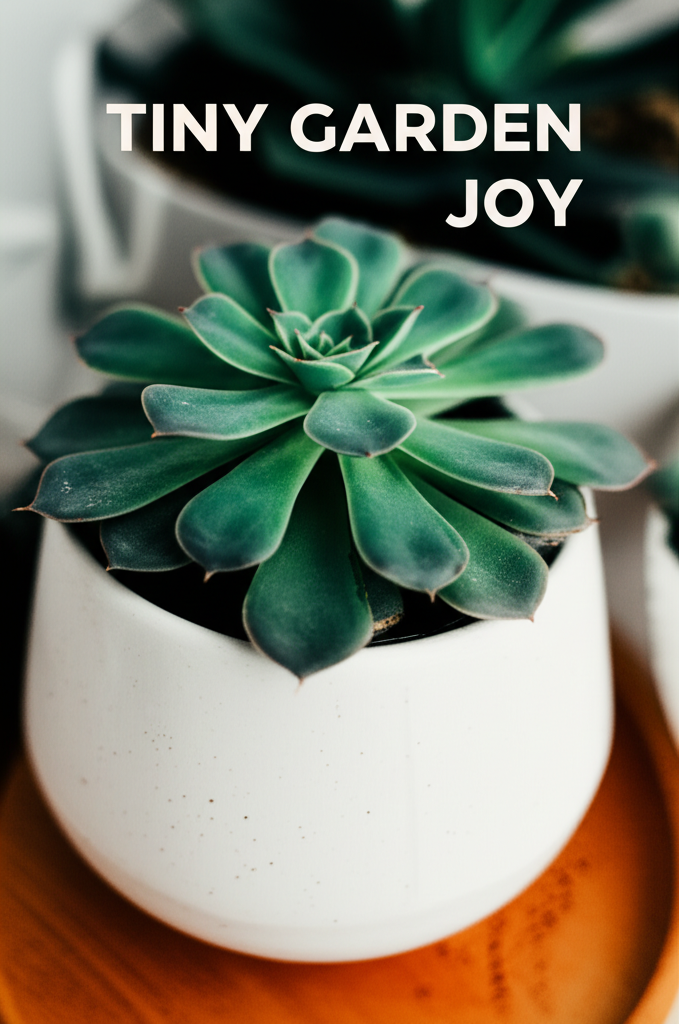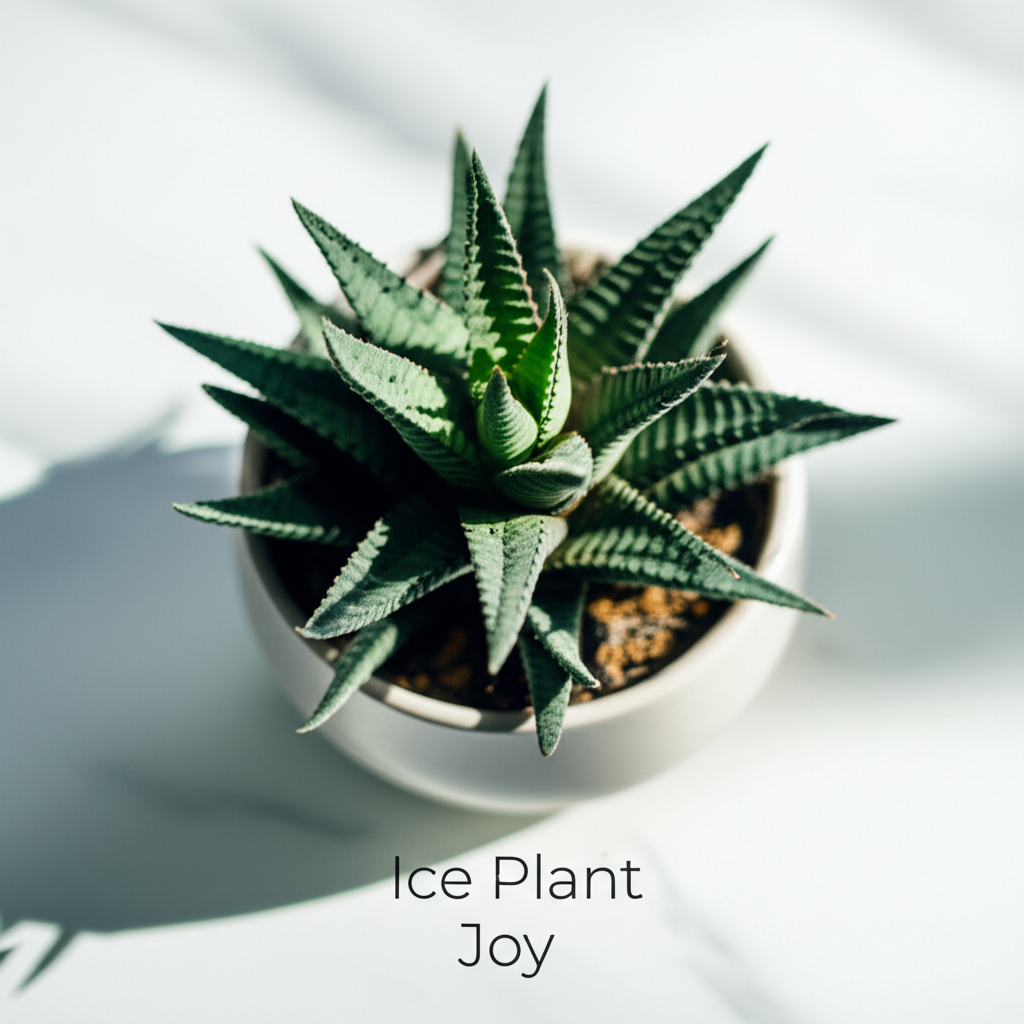Introduction: The Allure of the Ice Plant Succulent
Bringing a touch of the extraordinary into your home is often best achieved through the unique beauty of succulents. Among these captivating plants, the Ice Plant succulent, scientifically known as Delosperma, stands out. Renowned for its vibrant, jewel-toned flowers and unusual, glistening foliage that resembles ice crystals, the Ice Plant offers a mesmerizing addition to any indoor space. While often associated with outdoor rock gardens, these resilient plants can absolutely thrive indoors, transforming a windowsill or desk into a miniature desert oasis.
This comprehensive guide will delve into the specifics of cultivating a healthy and vibrant Ice Plant succulent indoor garden. We’ll cover everything from understanding its unique needs to troubleshooting common issues, ensuring your tiny garden flourishes. Whether you’re a seasoned succulent enthusiast or a beginner looking for an engaging and rewarding plant project, this article will provide you with the essential knowledge to succeed.
What Makes Ice Plant Succulents Special?
The defining characteristic of the Ice Plant succulent is its papillae, which are small, water-filled sacs on the surface of its leaves and stems. These papillae refract light, giving the plant its characteristic “ice-like” appearance. This adaptation is crucial for its survival in arid environments, helping it to capture and store moisture from the air. Beyond their unique texture, many Ice Plant varieties produce an abundance of small, daisy-like flowers in an array of brilliant colors, including vibrant pinks, purples, reds, and yellows, often blooming profusely throughout the warmer months.
Essential Care Requirements for Indoor Ice Plant Succulents

Successfully growing Ice Plant succulents indoors hinges on replicating their native desert conditions as closely as possible. This means paying particular attention to light, watering, soil, and temperature.
Light: The Sunshine Seeker
Ice Plants are sun-worshippers. Indoors, they require the brightest possible light to thrive and bloom.
- South-facing windows are ideal, providing the longest duration of direct sunlight.
- If a south-facing window isn’t available, a bright east or west-facing window can also work, though flowering might be less prolific.
- Supplemental grow lights are a fantastic option, especially during winter months or in homes with limited natural light. Full-spectrum LED grow lights are highly recommended for succulents.
- Insufficient light will lead to leggy growth (etiolation), pale coloration, and a lack of blooming.
Watering: The Art of Restraint
Overwatering is the most common pitfall when caring for succulents, and Ice Plants are no exception. They prefer to dry out completely between waterings.
- Water thoroughly until water drains from the drainage holes.
- Allow the soil to dry out completely before watering again. You can test this by sticking your finger about an inch into the soil; if it feels dry, it’s time to water.
- Reduce watering significantly during the dormant winter months.
- Use room-temperature water to avoid shocking the roots.
- Avoid letting the plant sit in standing water, as this can lead to root rot.
Soil: Drainage is Paramount
The key to healthy succulent roots is well-draining soil. Standard potting soil retains too much moisture for Ice Plants.
- Use a specialized succulent or cactus potting mix.
- You can create your own mix by combining potting soil with coarse sand, perlite, or pumice in a 1:1 or 2:1 ratio (potting soil to grit).
- The goal is to create a gritty, airy mix that allows water to pass through quickly.
Temperature and Humidity: Mimicking Arid Climates
Ice Plants are adaptable to a range of temperatures, but they prefer conditions that mimic their natural habitat.
- Ideal daytime temperatures range from 70-80°F (21-27°C).
- They can tolerate cooler temperatures at night, down to 50-60°F (10-15°C), which can actually encourage blooming.
- Avoid placing them near drafty windows or heating/cooling vents that can cause extreme temperature fluctuations.
- Ice Plants prefer low humidity. High indoor humidity can increase the risk of fungal diseases.
Potting and Repotting: Giving Them Space to Grow
Choosing the right pot and knowing when to repot are crucial for long-term health.
- Terracotta pots are excellent choices as they are porous and allow the soil to dry out more quickly, promoting good airflow.
- Ensure the pot has adequate drainage holes.
- Repot your Ice Plant succulent only when it becomes root-bound, typically every 2-3 years.
- The best time to repot is in the spring, at the beginning of its active growing season.
- When repotting, use fresh, well-draining soil and choose a pot that is only slightly larger than the previous one.
Propagating Your Ice Plant Succulent Garden
One of the joys of succulent gardening is the ease with which they can be propagated, allowing you to expand your collection or share with friends. Ice Plants are readily propagated from stem cuttings.
Stem Cuttings: A Simple Method
This is the most common and successful method for propagating Ice Plants.
- Using clean, sharp scissors or a knife, take stem cuttings of about 2-4 inches in length.
- Gently remove the lower leaves from the cutting, exposing a small portion of the stem.
- Allow the cuttings to callus over for a day or two in a dry, shaded spot. This prevents rot when planted.
- Once callused, insert the cut end of the stem into a well-draining succulent potting mix.
- Lightly mist the soil surface occasionally, but avoid overwatering.
- Place the cuttings in a bright location, but out of direct, intense sunlight.
- Roots typically develop within 3-6 weeks. You’ll know they’ve rooted when you see new growth.
Key Facts and Comparison: Ice Plant Succulents vs. Other Common Succulents
Understanding how Ice Plants compare to other popular indoor succulents can help you tailor your care and appreciate their unique qualities.
| Feature | Ice Plant (Delosperma) | Echeveria | Haworthia | Sedum (Stonecrop) |
|---|---|---|---|---|
| Foliage Appearance | Glistening papillae, crystalline texture | Rosette formation, often colorful | Tuberculated or striped leaves, often translucent tips | Fleshy leaves, varied shapes and colors |
| Blooming Habit | Abundant, daisy-like flowers (pink, purple, red, yellow) | Spikes of bell-shaped or star-shaped flowers | Slender spikes with small, often white or greenish flowers | Clusters of star-shaped flowers, typically yellow or pink |
| Light Needs | High, direct sunlight | High, bright indirect to direct sunlight | Medium to high, bright indirect light | High, direct sunlight |
| Watering | Drought tolerant, allow to dry completely | Drought tolerant, allow to dry completely | Drought tolerant, allow to dry completely | Drought tolerant, allow to dry completely |
| Soil Preference | Extremely well-draining, gritty mix | Well-draining succulent mix | Well-draining succulent mix | Well-draining succulent mix |
| Humidity Tolerance | Low | Low to medium | Low to medium | Low |
Troubleshooting Common Ice Plant Succulent Issues
Even with the best intentions, you might encounter a few problems. Here’s how to identify and resolve them.
Limp or Mushy Leaves
This is a classic sign of overwatering.
- Cause: Soil remains too wet for too long, leading to root rot.
- Solution: Immediately stop watering. If the soil is waterlogged, gently remove the plant from its pot and allow the roots to dry out in a well-ventilated area. Repot in fresh, dry, well-draining soil.
- Prevention: Ensure you are allowing the soil to dry out completely between waterings and that your pot has adequate drainage.
Stretched or Leggy Growth (Etiolation)
When a succulent stretches towards a light source, it’s not getting enough.
- Cause: Insufficient light.
- Solution: Move the plant to a brighter location, preferably a south-facing window or under a grow light. You can prune the leggy stems back to the base, and these cuttings can be propagated.
- Prevention: Provide consistent, bright light.
No Flowers
While primarily grown for their unique foliage, the flowers are a delightful bonus.
- Cause: Lack of sufficient light, improper dormancy period, or nutrient deficiency.
- Solution: Ensure the plant receives at least 6-8 hours of direct sunlight daily. Provide a cooler period during winter (50-60°F) with reduced watering to encourage blooming. A diluted succulent fertilizer applied sparingly in spring can help if nutrients are suspected.
- Prevention: Consistent bright light and a cooler winter rest.
Pests
While relatively pest-resistant, Ice Plants can occasionally be affected by common houseplant pests.
- Common Pests: Mealybugs and spider mites are the most likely culprits.
- Identification: Mealybugs appear as white, cottony masses, often in leaf axils. Spider mites are tiny, red or brown, and create fine webbing.
- Solution: Isolate the affected plant. For minor infestations, use a cotton swab dipped in rubbing alcohol to dab the pests. For more severe cases, a horticultural soap or neem oil spray can be effective. Ensure good air circulation to deter pests.
Seasonal Care: Adapting to the Year
Your Ice Plant’s needs will shift slightly throughout the year, particularly with the change in light and temperature.
Spring: The Awakening
As days lengthen and temperatures rise, your Ice Plant will emerge from its winter dormancy and begin active growth.
- Increase watering frequency as the soil dries out more quickly.
- This is an excellent time for propagation.
- Consider a light feeding with a diluted succulent fertilizer if the plant hasn’t been fertilized in a year.
Summer: Peak Performance
This is when your Ice Plant will likely be at its most vibrant, with potential for abundant flowering.
- Continue with consistent watering, allowing the soil to dry out between waterings.
- Ensure it receives ample bright light.
- Monitor for pests, as warmer temperatures can sometimes encourage their activity.
Autumn: Preparing for Rest
As the days shorten and temperatures begin to cool, your Ice Plant will start to slow its growth.
- Gradually reduce watering.
- If you’re moving the plant indoors for the winter, do so before the first frost.
- Check for any signs of pests before bringing it inside.
Winter: The Dormant Period
The winter months are a time of rest for Ice Plants.
- Significantly reduce watering; water only if the plant shows signs of extreme dehydration.
- Ensure the plant is in its brightest possible location, as natural light is at its lowest.
- Maintain cooler temperatures if possible, as this can promote healthier dormancy and encourage spring blooms.
Pros and Cons of Indoor Ice Plant Cultivation
Like any plant, there are advantages and disadvantages to growing Ice Plants indoors.
| Pros | Cons |
|---|---|
| Unique, eye-catching foliage with a “crystalline” appearance. | Requires very bright light, which can be challenging to provide consistently indoors. |
| Produces vibrant, abundant flowers that add a splash of color. | Susceptible to root rot if overwatered. |
| Easy to propagate from stem cuttings, allowing for collection expansion. | Can become leggy and lose its compact form if light is insufficient. |
| Drought-tolerant, making them forgiving if you occasionally forget to water. | May not bloom as profusely indoors compared to ideal outdoor conditions. |
| Low humidity requirements make them suitable for most indoor environments. | Pest management might be necessary, particularly for mealybugs and spider mites. |
Conclusion: A Glistening Gem for Your Home
The Ice Plant succulent, with its shimmering foliage and vibrant floral displays, offers a unique and rewarding experience for indoor gardeners. By understanding and replicating its fundamental needs for bright light, well-draining soil, and careful watering, you can cultivate a thriving miniature garden that brings a touch of desert magic into your living space. Embrace the simplicity and resilience of these fascinating plants, and enjoy the unique beauty they bring to your home. Remember that observation and a willingness to adapt your care based on your specific environment are key to success. Happy gardening!


